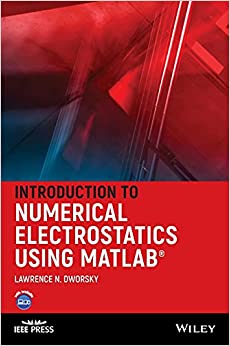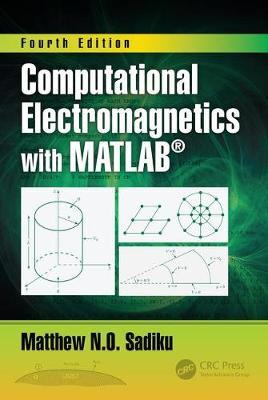Introduction to Numerical Electrostatics Using MATLAB
Original price was: ₹7,484.54.₹5,987.63Current price is: ₹5,987.63.
ISBN: 9781118449745
Author/Editor: Lawrence N Dworsky
Publisher: John Wiley
Year: 2014
1 in stock (can be backordered)
Description
Readers are guided step by step through numerous specific problems and challenges, covering all aspects of electrostatics with an emphasis on numerical procedures. The author focuses on practical examples, derives mathematical equations, and addresses common issues with algorithms. Introduction to Numerical Electrostatics contains problem sets, an accompanying web site with simulations, and a complete list of computer codes. * Computer source code listings on accompanying web site * Problem sets included with book * Readers using MATLAB or other simulation packages will gain insight as to the inner workings of these packages, and how to account for their limitations * Example computer code is provided in MATLAB * Solutions Manual * The first book of its kind uniquely devoted to the field of computational electrostatics
Additional information
| Weight | 0.962 kg |
|---|
Product Properties
| Year of Publication | 2014 |
|---|---|
| Table of Contents | Preface xi Introduction xiii Acknowledgments xv 1 A Review of Basic Electrostatics 1 1.1 Charge, Force, and the Electric Field 1 1.2 Electric Flux Density and Gauss's Law 5 1.3 Conductors 7 1.4 Potential, Gradient, and Capacitance 10 1.5 Energy in the Electric Field 16 1.6 Poisson's and Laplace's Equations 18 1.7 Dielectric Interfaces 20 1.8 Electric Dipoles 24 1.9 The Case for Approximate Numerical Analysis 27 2 The Uses of Electrostatics 33 2.1 Basic Circuit Theory 33 2.2 Radio Frequency Transmission Lines 41 2.3 Vacuum Tubes and Cathode Ray Tubes 44 2.4 Field Emission and the Scanning Electron Microscope 47 2.5 Electrostatic Force Devices 48 2.6 Gas Discharges and Lighting Devices 49 3 Introduction to the Method of Moments Technique for Electrostatics 51 3.1 Fundamental Equations 51 3.2 A Working Equation Set 55 3.3 The Single-Point Approximation for Off-Diagonal Terms 56 3.4 Exact Solutions for the Diagonal Term and In-Plane Terms 57 3.5 Approximating Lij 61 4 Examples using the Method of Moments 67 4.1 A First Modeling Program 67 4.2 Input Data File Preparation for the First Modeling Program 68 4.3 Processing the Input Data 71 4.4 Generating the Lij Array 73 4.5 Solving the System and Examining Some Results 73 4.6 Limits of Resolution 76 4.7 Voltages and Fields 78 4.8 Varying the Geometry 82 5 Symmetries, Images and Dielectrics 89 5.1 Symmetries 89 5.2 Images 90 5.3 Multiple Images and the Symmetric Stripline 95 5.4 Dielectric Interfaces 102 5.5 Two-Dimensional Cross Sections of Uniform Three-Dimensional Structures 108 5.6 Charge Profiles and Current Bunching 113 5.7 Cylinder between Two Planes 116 6 Triangles 123 6.1 Introduction to Triangular Cells 123 6.2 Right Triangles 124 6.3 Calculating Lii (Self ) Coefficients 125 6.4 Calculating Lij for i 6 not equal j 127 6.5 Basic Meshing and Data Formats for Triangular Cell MoM Programs 127 6.6 Using MATLAB to Generate Triangular Meshings 135 6.7 Calculating Voltages 139 6.8 Calculating the Electric Field 141 6.9 Three-Dimensional Structures 143 6.10 Charge Profiles 152 7 Summary and Overview 159 7.1 Where We Were, Where We're Going 159 8 The Finite Difference Method 163 8.1 Introduction and a Simple Example 163 8.2 Setting Up and Solving a Basic Problem 165 8.3 The Gauss Seidel (Relaxation) Solution Technique 172 8.4 Charge, Gauss's Law, and Resolution 175 8.5 Voltages and Fields 177 8.6 Stored Energy and Capacitance 178 9 Refining the Finite Difference Method 183 9.1 Refined Grids 183 9.2 Arbitrary Conductor Shapes 189 9.3 Mixed Dielectric Regions and a New Derivation of the Finite Difference Equation 194 9.4 Example: Structure with a Dielectric Interface 195 9.5 Axisymmetric Cylindrical Coordinates 196 9.6 Symmetry Boundary Condition 205 9.7 Duality, and Upper and Lower Bounds to Solutions for Transmission Lines 207 9.8 Extrapolation 214 9.9 Three-Dimensional Grids 217 10 Multielectrode Systems 227 10.1 Multielectrode Structures 227 10.2 Utilizing Superposition 229 10.3 Utilizing Symmetry 230 10.4 Circuital Relations and a Caveat 230 10.5 Floating Electrodes 232 11 Probabilistic Potential Theory 237 11.1 Random Walks and the Diffusion Equation 237 11.2 Voltage at a Point from Random Walks 239 11.3 Diffusion 246 11.4 Variable-Step-Size Random Walks 249 11.5 Three-Dimensional Structures 260 12 The Finite Element Method (FEM) 265 12.1 Introduction 265 12.2 Solving Laplace's Equation by Minimizing Stored Energy 266 12.3 A Simple One-Dimensional Example 267 12.4 A Very Simple Finite Element Approximation 271 12.5 Arbitrary Number of Lines Approximation 274 12.6 Mixed Dielectrics 278 12.7 A Quadratic Approximation 279 12.8 A Simple Two-Dimensional FEM Program 282 13 Triangles and Two-Dimensional Unstructured Grids 289 13.1 Introduction 289 13.2 Aside: The Area of a Triangle 290 13.3 The Coefficient Matrix 291 13.4 A Simple Example 293 13.5 A Two-Dimensional Triangular Mesh Program 296 14 A Zoning System and Some Examples 303 14.1 General Introduction 303 14.2 Introduction to gmsh 304 14.3 Translating the gmsh.msh File 308 14.4 Running the FEM Analysis 319 14.5 More gmsh Features and Examining the Electric Field 320 14.6 Multiple Electrodes 324 15 Some FEM Topics 329 15.1 Symmetries 329 15.2 A Symmetry Example, Including a Two-Sided Capacitance Estimate 330 15.3 Axisymmetric Structures 337 15.4 The Graded-Potential Boundary Condition 348 15.5 Unbounded Regions 352 15.6 Dielectric Materials 364 16 FEM in Three Dimensions 375 16.1 Creating Three-Dimensional Meshes 375 16.2 The FEM Coefficient Matrix in Three Dimensions 384 16.3 Parsing the gmsh Files and Setting Boundary Conditions 386 16.4 Open Boundaries and Cylinders in Space 392 17 Electrostatic Forces 399 17.1 Introduction 399 17.2 Electron Beam Acceleration and Control 400 17.3 The Electrostatic Relay (Switch) 408 17.4 Electrets and Piezoelectricity: An Overview 414 17.5 Points on a Sphere 415 Problems 419 Appendix Interfacing with Other Languages 423 Index 431 |
| Author | Lawrence N Dworsky |
| ISBN/ISSN | 9781118449745 |
| Binding | Hardback |
| Edition | 1 |
| Publisher | John Wiley |
You must be logged in to post a review.






Reviews
There are no reviews yet.